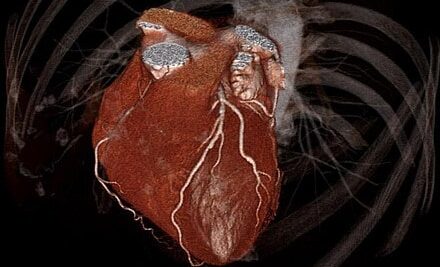|
CT-First CAD | Full-Body Uproar
March 6, 2022
|
|
|

|
|
Together with
|

|
|
|
“A yearly dose of radiation for no reason seems really counterproductive to ‘longevity medicine.’”
|
|
One Twitter response to Dr. Peter Diamandis’ endorsement of annual “Full-Body Health Uploads” that include both CTs and full-body MRIs.
|
|

|
|
A major new study from the DISCHARGE Trial Group showed that coronary CT is as effective as invasive coronary angiography (ICA) for the management of patients with obstructive coronary artery disease (CAD), potentially challenging current guidelines.
Background – Invasive coronary angiography (ICA) is the reference standard for diagnosing and managing CAD and it’s performed over 3.5 million times each year in the European Union alone (many more millions globally). However, over 60% of these exams prove negative and theoretically could have been diagnosed via non-invasive CT exams.
The Study – The randomized, multi-center trial (26 sites, 16 EU countries) used CT or ICA as the initial diagnostic and treatment guidance exam for 3,523 patients with stable chest pain and intermediate probability of obstructive CAD (1,808 patients w/ CT). By the end of the study’s 3.5-year follow-up period, patients in the CT group had:
- A lower rate of major adverse cardiovascular events (2.1% vs. 3% w/ ICA)
- A far lower major procedure-related complication rate (0.5% vs. 1.9% w/ ICA)
- A slightly higher rate of reported angina (8.8% vs. 7.5% w/ ICA)
The Takeaway
These results suggest that following a CT-first strategy for evaluating patients with a medium risk of CAD produces similar longer-term outcomes as the current ICA-first strategy (maybe even better outcomes), while significantly reducing major complications and unnecessary cath lab procedures.
That’s pretty compelling and could actually influence procedural changes, given the size / credibility of the DISCHARGE Trial Group and the fact that CT was already proposed in the Chest Pain Guidelines as a gatekeeper for invasive coronary angiography.
|




|
|
Radiology Associates of Daytona & Fujifilm’s Patient Experience Boost
Think your imaging center patients and admin staff might be open to a better check-in process? See how Radiology Associates of Daytona (RA) streamlined patient check-ins with Fujifilm’s Synapse RIS-integrated Royal Kiosks.
|
|
Making Your AI Business Case
Working out your AI business case? Check out this helpful Blackford Analysis post outlining the three steps to help you justify AI adoption.
|
|
- Full-Body Uproar: Entrepreneur, physician, and longevity guru, Dr. Peter Diamandis, absorbed some fierce MedTwitter backlash last week after endorsing annual “Full-Body Health Uploads” that include both CTs and full-body MRIs. Commenters had the greatest concerns about the radiation exposure and overdiagnosis risks that these annual scans pose, and ethical concerns that his advice might be financially motivated. They also got a laugh out of the yearly Health Uploads’ inclusion of genomic exams, which might prove necessary after all those CTs.
- Handheld Ultrasound Cirrhosis Assessments: A new study out of Italy suggests that handheld ultrasound could be a valuable first-line tool for chronic liver disease screening. The researchers scanned 104 consecutive patients using GE Healthcare’s VScan DualProbe handheld, a traditional cart-based ultrasound, and a transient elastography ultrasound system. The GE handheld diagnosed asymptomatic cirrhosis with the same sensitivity as the mainstream ultrasound systems (all 87.5%) and similar or lower specificity (76.8% vs. 72.6% & 90.5%), suggesting that handhelds could be effective for ruling out advanced chronic liver disease.
- RadNet Builds: RadNet’s recent earnings call revealed a strategic shift towards building net new imaging centers, including 15 new locations that are currently being developed. RadNet has typically been an aggressive acquirer and even confirmed its M&A focus six months ago. However, the imaging center giant believes that it is currently “better to build” new locations because larger imaging centers are being acquired for far more than its targeted multiples (RadNet’s target = 3-6x EBITDA) and fewer centers are available for acquisition in RadNet’s markets.
- Pediatric CT DLIR: A new AJR study out of Japan shared what might be the first evidence of CT deep learning image reconstruction’s effectiveness with pediatric patients. The researchers reconstructed 31 standard-dose pediatric CTs using iterative reconstruction and reconstructed 34 low-dose CT exams using DLIR, hybrid IR, and model-based IR (all ≤6 years, contrast-enhanced CTs, low dose = -54%). Reviewing radiologists found the DLIR-enhanced exams to have significantly better image quality, lower image noise, and higher signal-to-noise and contrast-to-noise ratios.
- The AI Adoption Catalyst: A new editorial from Chris Wood (founder of Reveal-Dx, Clario, and Confirma) argues that the first wave of radiology AI startups largely “failed because technology catalysts don’t work in health care.” Although the next wave of AI will still need the basics to succeed (target real problems, perform & generalize well, fit radiologist workflows), the most successful products will capitalize on major healthcare-wide catalysts (e.g. value-based care, precision medicine, major policy or reimbursement changes).
- MSFT + Nuance Complete: Microsoft officially completed its $16B acquisition of Nuance, reiterating its strategy to combine Microsoft’s cloud capabilities and global scale with Nuance’s conversational AI and ambient intelligence tech. The announcement once again positioned Nuance at the center of Microsoft’s healthcare ambitions, suggesting that we’re about to see an ambitious healthcare push from the combined companies.
- Image Viewing and Behavior Change: A new PLOS Medicine study review suggests that showing patients their medical images can drive health and wellness behavior changes. The analysis (n = 21 studies, 9,248 patients) found image-based feedback motivated patients to stop smoking (risk ratio: 1.11), adopt healthier diets (standardized mean difference / SDM: 0.30), increase physical activity (SDM: 0.11), and improve oral hygiene behaviors (SDM: 0.35). These behavior changes directly resulted in health improvements (e.g. reduced blood pressure, smaller waist circumference), and might suggest that imaging deserves a greater role in behavioral interventions.
- GLEAMER’s BoneView FDA: French AI startup GLEAMER announced the FDA clearance of its BoneView software, which helps clinicians detect, localize, and diagnose fractures in X-ray exams. GLEAMER’s first FDA clearance and upcoming US expansion are major milestones, coming two years after BoneView gained its European CE Mark and following its adoption at 300 institutions in 13 countries. It also comes a few months after the solution was highlighted in a very positive Radiology Journal study.
- Children’s Hospital Non-Compliance: A new JAMA study revealed that only 39% of the top 89 US children’s hospitals’ outpatient imaging services are fully compliant with federal transparency rules. Although nearly all of the hospitals were compliant with the shoppable services requirement (98%), many did not display min/max negotiated rates, payer negotiated rates, and cash rates (51%, 51%, 40% not compliant). Even the fully compliant hospitals had significant cash rate variations (led by retroperitoneal ultrasound’s 84% variation) and negotiated rate markups over Medicare reimbursements (led by brain MRI’s $1,693 vs $230 markup).
- Ontario Imaging Center Merger: Clear Medical Imaging (10 imaging centers) significantly expanded within its southwest Ontario area market, announcing its merger with neighboring imaging center company, CMR Healthcare (9 centers). The agreement will close in March and the organizations will operate under the Clear Medical Imaging brand by Q3.
- Resident Burnout: A new Academic Radiology study revealed high levels of burnout among American radiology residents (n = 247 residents, 11 medical centers). The 2017-2018 survey revealed widespread burnout and sleep impairment (64.8% & 36.2%) and low professional fulfillment (37.4%), but only 7.6% said that they planned to leave residency.
|
|
Lighting New Population Health Pathways
See how Nanox AI’s population health solutions are helping health systems and payers to improve the quality and cost of care through early disease detection.
|
|
- See Dr. Brian Goldner of UC Davis Sacramento detail his experience with Canon’s Ultra High Resolution CT and how it can be applied to cardiothoracic interpretations.
- This Bayer case study details how radiation benchmarking programs can help push CT dose exposure reduction initiatives from achieving compliance to driving quality.
- Associated Urologists of North Carolina just became the latest home of one of United Imaging’s uCT 530 CT systems. See why Associated Urologists’ Cary, NC office called United Imaging’s CT team “the best.”
- Hybrid care, digitization, and the move to the cloud are three of Intelerad’s Five Healthcare Trends to Watch detailed in this spot-on report.
- Do your radiologists want faster and less manual access to imaging studies? See how the Indiana Health Information Exchange (IHIE), the largest inter-organizational clinical data repository in the US, cut its imaging study retrieval time by 94% when it adopted Nuance PowerShare.
- See how GE Healthcare’s new Revolution Ascend CT system’s Effortless Workflow helps radiologists and technologists become more efficient by addressing the most time-consuming part of the CT experience: the steps required outside the scan.
- Thinking about adding PET/CT to your clinical offerings but don’t have the patient volume to support a full-time scanner? Check out Siemens Healthineers’ fleet of Biograph mobile PET/CT solutions to learn how we can provide reliable, high-quality imaging with a focus on the patient experience – no matter the location.
- We talk a lot about radiology practices’ AI adoption, but usually don’t have much evidence to back it up. That changes with this new Arterys report detailing how and why 30 US radiology groups became imaging AI adopters.
|
|
|
|
|